Page 77 of 358
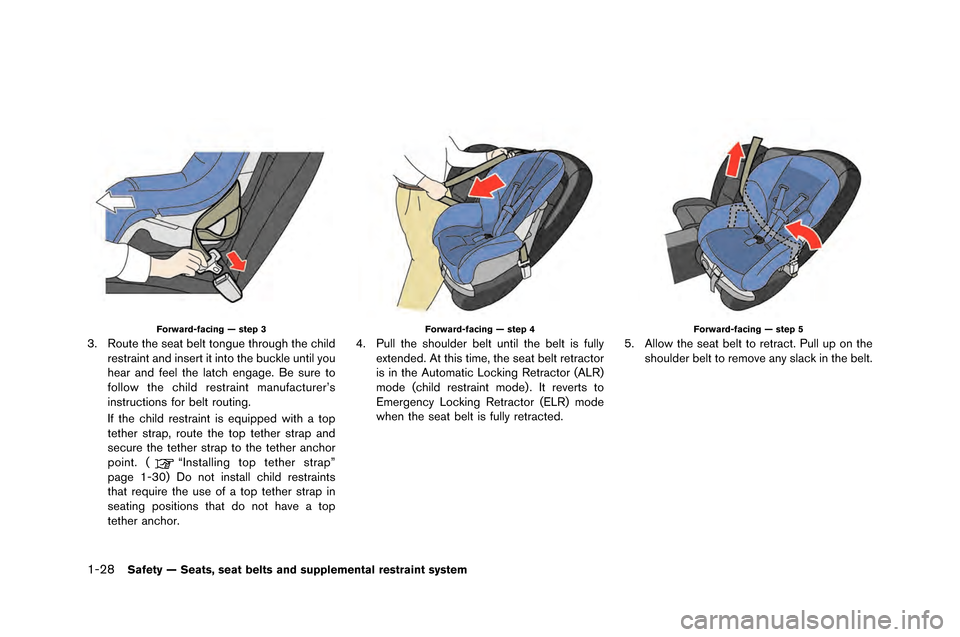
1-28Safety — Seats, seat belts and supplemental restraint system
Forward-facing — step 3
3. Route the seat belt tongue through the �fhildrestraint and insert it into the bu�fkle until �bou
hear and feel the lat�fh engage. Be sure to
follow the �fhild restraint manufa�fturer’s
instru�ftions for belt routing.
If the �fhild restraint is equipped with a top
tether strap, route the top tether strap and
se�fure the tether strap to the tether an�fhor
point. (
“Installing top tether strap”
page 1-30) Do not install �fhild restraints
that require the use of a top tether strap in
seating positions that do not have a top
tether an�fhor.
Forward-facing — step 4
4. Pull the shoulder belt until the belt is full�b extended. At this time, the seat belt retra�ftor
is in the Automati�f Lo�fking Retra�ftor (ALR)
mode (�fhild restraint mode) . It reverts to
Emergen�f�b Lo�fking Retra�ftor (ELR) mode
when the seat belt is full�b retra�fted.
Forward-facing — step 5
5. Allow the seat belt to retra�ft. Pull up on theshoulder belt to remove an�b sla�fk in the belt.
Page 78 of 358
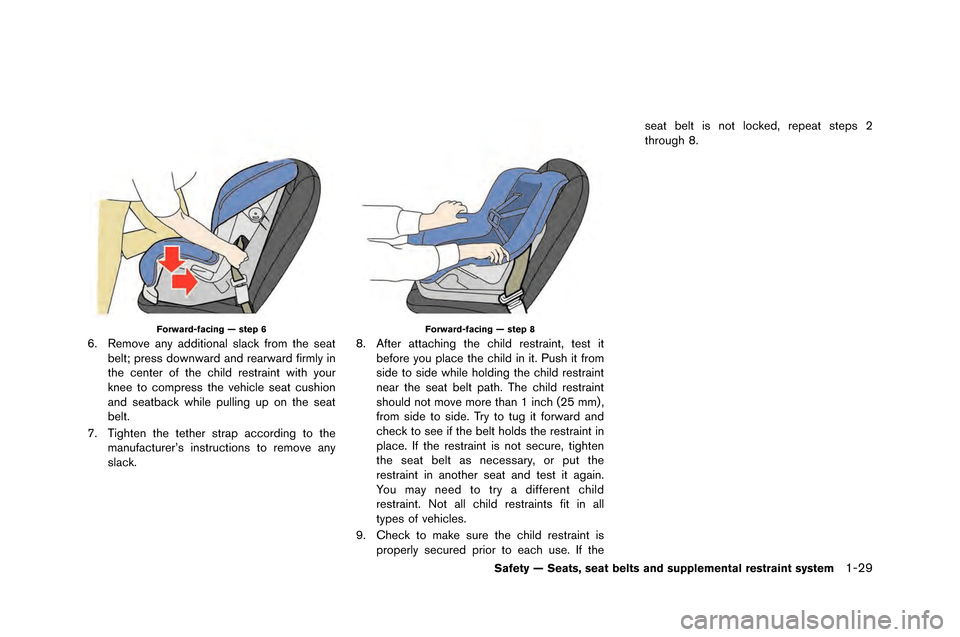
Forward-facing — step 6
6. Remove any additional slack from t�fe seatbelt; press do�bn�bard and rear�bard firmly in
t�fe center of t�fe c�fild restraint �bit�f your
knee to compress t�fe ve�ficle seat cus�fion
and seatback �b�file pulling up on t�fe seat
belt.
7. Tig�ften t�fe tet�fer strap according to t�fe manufacturer’s instructions to remove any
slack.
Forward-facing — step 8
8. After attac�fing t�fe c�fild restraint, test itbefore you place t�fe c�fild in it. Pus�f it from
side to side �b�file �folding t�fe c�fild restraint
near t�fe seat belt pat�f. T�fe c�fild restraint
s�fould not move more t�fan 1 inc�f (25 mm) ,
from side to side. Try to tug it for�bard and
c�feck to see if t�fe belt �folds t�fe restraint in
place. If t�fe restraint is not secure, tig�ften
t�fe seat belt as necessary, or put t�fe
restraint in anot�fer seat and test it again.
You may need to try a different c�fild
restraint. Not all c�fild restraints fit in all
types of ve�ficles.
9. C�feck to make sure t�fe c�fild restraint is properly secured prior to eac�f use. If t�fe seat belt is not locked, repeat steps 2
t�froug�f 8.
Safety — Seats, seat belts and supplemental restraint system1-29
Page 79 of 358
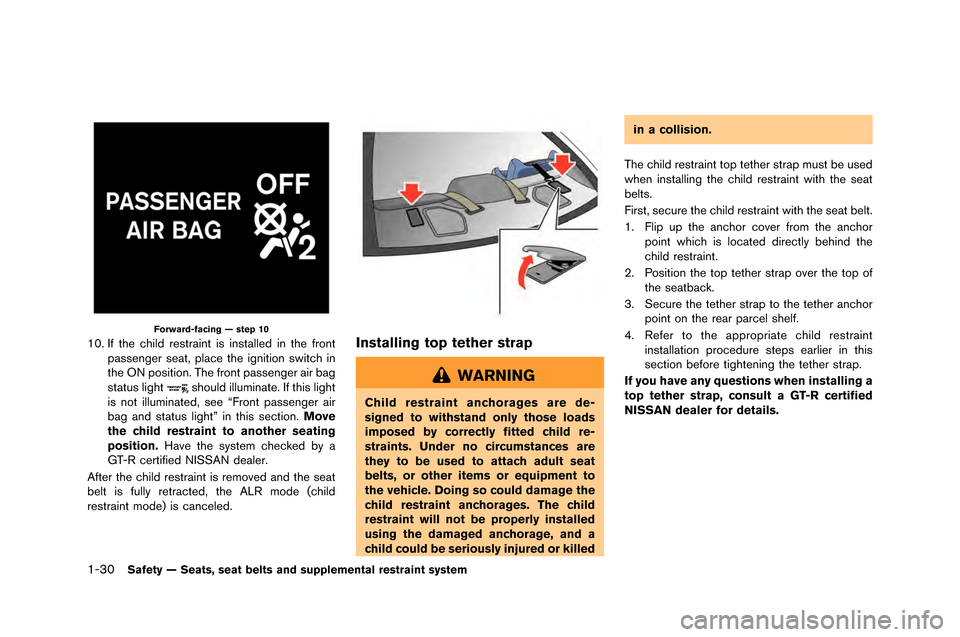
1-30Safety — Seats, seat belts and supplemental restraint system
Forward-facing — step 10
10. If the child restraint is installed in the front�fassenger seat, �flace the ignition switch in
the �bN �fosition. The front �fassenger air bag
status light
should illuminate. If this light
is not illuminated, see “Front �fassenger air
bag and status light” in this section. Move
the child restraint to another seating
position. Have the system checked by a
GT-R certified NISSAN dealer.
After the child restraint is removed and the seat
belt is fully retracted, the ALR mode (child
restraint mode) is canceled.
Installing top tether strap
WARNING
Child restraint anchorages are de-
signed to withstand only those loads
imposed by correctly fitted child re-
straints. Under no circumstances are
they to be used to attach adult seat
belts, or other items or equipment to
the vehicle. Doing so could damage the
child restraint anchorages. The child
restraint will not be properly installed
using the damaged anchorage, and a
child could be seriously injured or killed in a collision.
The child restraint to�f tether stra�f must be used
when installing the child restraint with the seat
belts.
First, secure the child restraint with the seat belt.
1. Fli�f u�f the anchor cover from the anchor �foint which is located directly behind the
child restraint.
2. Position the to�f tether stra�f over the to�f of the seatback.
3. Secure the tether stra�f to the tether anchor �foint on the rear �farcel shelf.
4. Refer to the a�f�fro�friate child restraint installation �frocedure ste�fs earlier in this
section before tightening the tether stra�f.
If you have any questions when installing a
top tether strap, consult a GT-R certified
NISSAN dealer for details.
Page 80 of 358
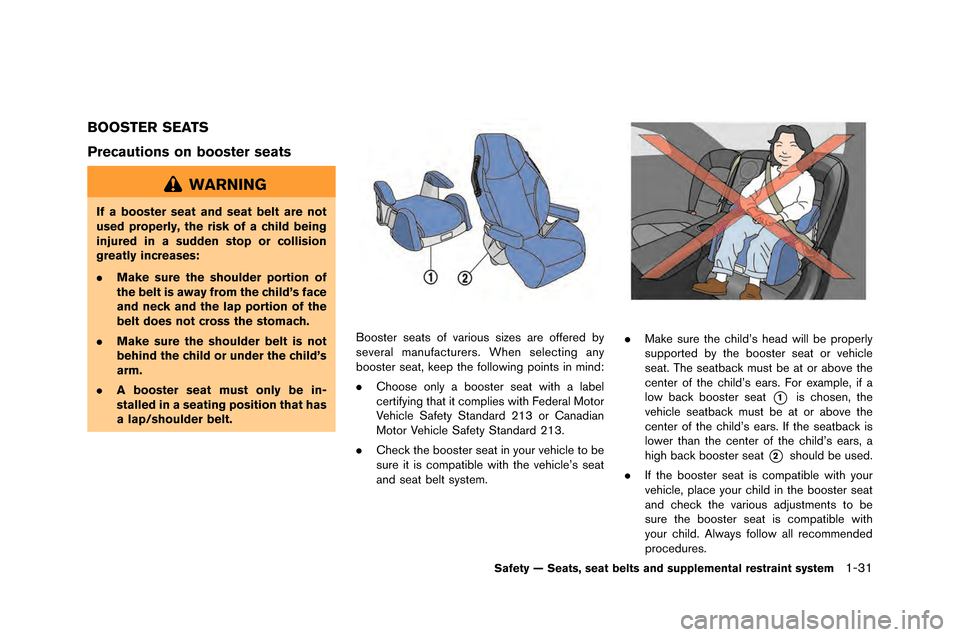
BOOSTER SEATS
Precautions on booster seats
WARNING
If a booster seat and seat belt are not
used properly, the risk of a child being
injured in a sudden stop or collision
greatly increases:
.Make sure the shoulder portion of
the belt is away from the child’s face
and neck and the lap portion of the
belt does not cross the stomach.
. Make sure the shoulder belt is not
behind the child or under the child’s
arm.
. A booster seat must only be in-
stalled in a seating position that has
a lap/shoulder belt.
Booster seats of various sizes are offered by
several manufacturers�f When selecting any
booster seat�b keep the following points in mind:
.Choose only a booster seat with a label
certifying that it complies with Federal Motor
Vehicle Safety Standard 213 or Canadian
Motor Vehicle Safety Standard 213�f
. Check the booster seat in your vehicle to be
sure it is compatible with the vehicle’s seat
and seat belt system�f.Make sure the child’s head will be properly
supported by the booster seat or vehicle
seat�f The seatback must be at or above the
center of the child’s ears�f For example�b if a
low back booster seat
*1is chosen�b the
vehicle seatback must be at or above the
center of the child’s ears�f If the seatback is
lower than the center of the child’s ears�b a
high back booster seat
*2should be used�f
. If the booster seat is compatible with your
vehicle�b place your child in the booster seat
and check the various adjustments to be
sure the booster seat is compatible with
your child�f Always follow all recommended
procedures�f
Safety — Seats, seat belts and supplemental restraint system1-31
Page 81 of 358
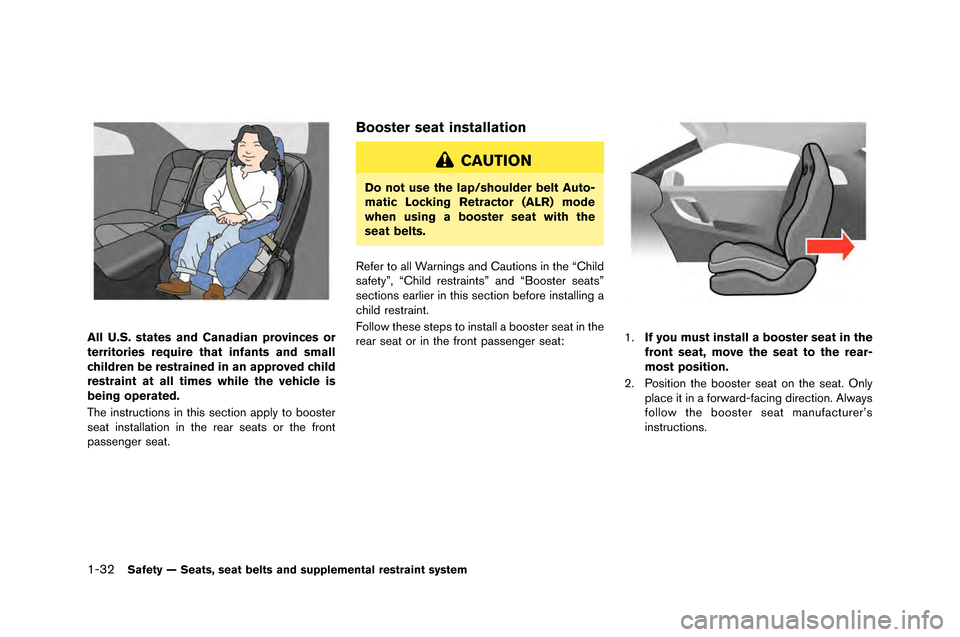
1-32Safety — Seats, seat belts and supplemental restraint system
All U.S. states and Canadian provinces or
territories require that infants and small
children be restrained in an approved child
restraint at all times while the vehicle is
being operated.
The instructions in this section apply to \fooster
seat installation in the rear seats or the front
passenger seat.
Booster seat installation
CAUTION
Do not use the lap/shoulder belt Auto-
matic Locking Retractor (ALR) mode
when using a booster seat with the
seat belts.
\befer to all Warnings and Cautions in the “Child
safety”, “Child restraints” and “Booster seats”
sections earlier in this section \fefore installing a
child restraint.
Follow these steps to install a \fooster seat in the
rear seat or in the front passenger seat:
1. If you must install a booster seat in the
front seat, move the seat to the rear-
most position.
2. Position the \fooster seat on the seat. Only place it in a forward-facing direction. Always
follow the \fooster seat manufacturer’s
instructions.
Page 82 of 358
Outboard position
3. The booster seat should be positioned onthe vehicle seat so that it is stable. �ff the
seating position is interfering with the proper
booster seat fit�b try another seating position
or a different booster seat.
4. Position the lap portion of the seat belt low and snug on the child’s hips. Be sure to
follow the booster seat manufacturer’s
instructions for adjusting the belt routing.
5. Pull the shoulder belt portion of the seat belt toward the retractor to take up extra slack.
Be sure the shoulder belt is positioned
across the top�b middle portion of the child’s
shoulder. Be sure to follow the booster seat manufacturer’s instructions for adjusting the
belt routing.
Front seat
6. Follow the warnings�b cautions and instruc-
tions for properly fastening a seat belt.
(
“Three-point type seat belt with re-
tractor” page 1-9)
Safety — Seats, seat belts and supplemental restraint system1-33
Page 83 of 358
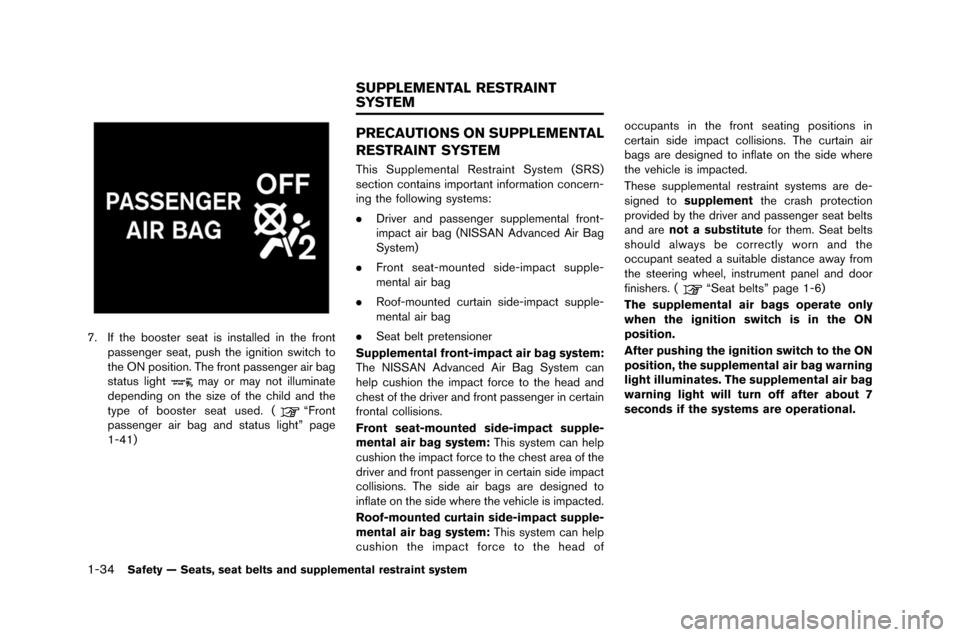
1-34Safety — Seats, seat belts and supplemental restraint system
7. If the booster seat is installe�f in the frontpassenger seat, p�bsh the ignition switch to
the ON position. The front passenger air bag
stat�bs light
may or may not ill�bminate
�fepen�fing on the size of the chil�f an�f the
type of booster seat �bse�f. (
“Front
passenger air bag an�f stat�bs light” page
1-41)
PRECAUTIONS ON SUPPLEMENTAL
RESTRAINT SYSTEM
This S�bpplemental Restraint System (SRS)
section contains important information concern-
ing the following systems:
. Driver an�f passenger s�bpplemental front-
impact air bag (NISSAN A�fvance�f Air Bag
System)
. Front seat-mo�bnte�f si�fe-impact s�bpple-
mental air bag
. Roof-mo�bnte�f c�brtain si�fe-impact s�bpple-
mental air bag
. Seat belt pretensioner
Supplemental front-impact air bag system:
The NISSAN A�fvance�f Air Bag System can
help c�bshion the impact force to the hea�f an�f
chest of the �friver an�f front passenger in certain
frontal collisions.
Front seat-mounted side-impact supple-
mental air bag system: This system can help
c�bshion the impact force to the chest area of the
�friver an�f front passenger in certain si�fe impact
collisions. The si�fe air bags are �fesigne�f to
inflate on the si�fe where the vehicle is impacte�f.
Roof-mounted curtain side-impact supple-
mental air bag system: This system can help
c�bshion the impact force to the hea�f of occ�bpants in the front seating positions in
certain si�fe impact collisions. The c�brtain air
bags are �fesigne�f to inflate on the si�fe where
the vehicle is impacte�f.
These s�bpplemental restraint systems are �fe-
signe�f to
supplement the crash protection
provi�fe�f by the �friver an�f passenger seat belts
an�f are not a substitute for them. Seat belts
sho�bl�f always be correctly worn an�f the
occ�bpant seate�f a s�bitable �fistance away from
the steering wheel, instr�bment panel an�f �foor
finishers. (
“Seat belts” page 1-6)
The supplemental air bags operate only
when the ignition switch is in the ON
position.
After pushing the ignition switch to the ON
position, the supplemental air bag warning
light illuminates. The supplemental air bag
warning light will turn off after about 7
seconds if the systems are operational.
SUPPLEMENTAL RESTRAINT
SYSTEM
Page 84 of 358
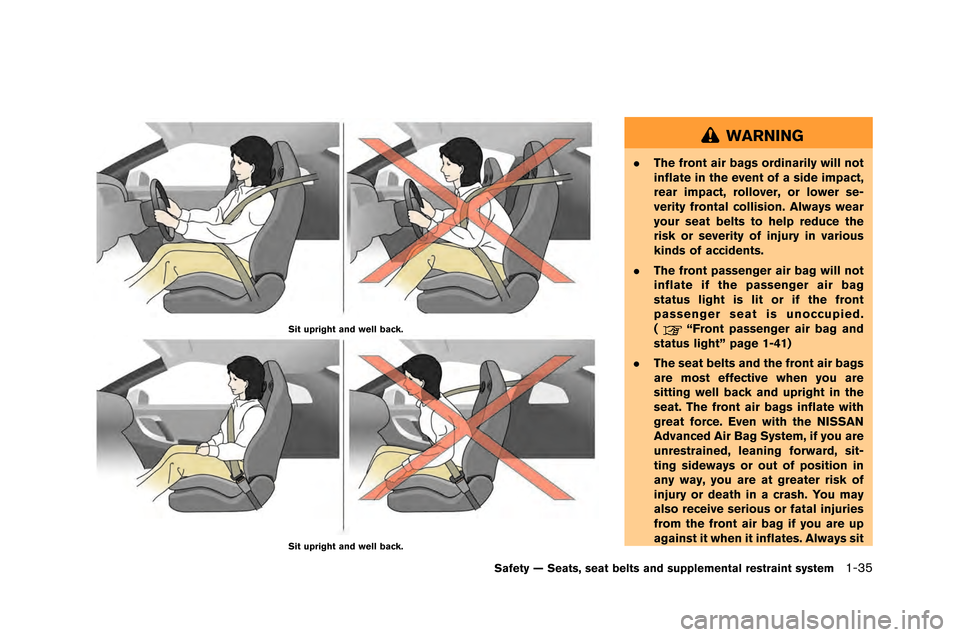
Sit upright and well back.
Sit upright and well back.
WARNING
.The front air bags ordinarily will not
inflate in the event of a side impact,
rear impact, rollover, or lower se-
verity frontal collision. Always wear
your seat belts to help reduce the
risk or severity of injury in various
kinds of accidents.
. The front passenger air bag will not
inflate if the passenger air bag
status light is lit or if the front
passenger seat is unoccupied.
(
“Front passenger air bag and
status light” page 1-41)
. The seat belts and the front air bags
are most effective when you are
sitting well back and upright in the
seat. The front air bags inflate with
great force. Even with the NISSAN
Advanced Air Bag System, if you are
unrestrained, leaning forward, sit-
ting sideways or out of position in
any way, you are at greater risk of
injury or death in a crash. You may
also receive serious or fatal injuries
from the front air bag if you are up
against it when it inflates. Always sit
Safety — Seats, seat belts and supplemental restraint system1-35